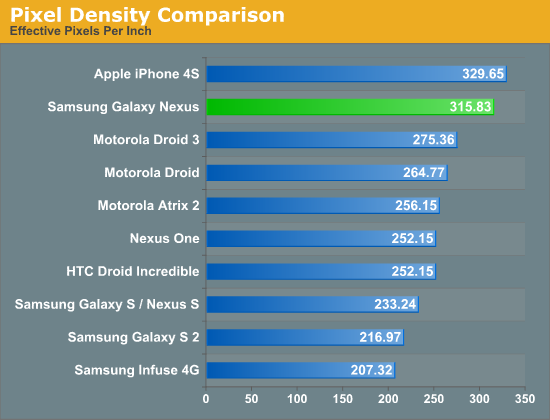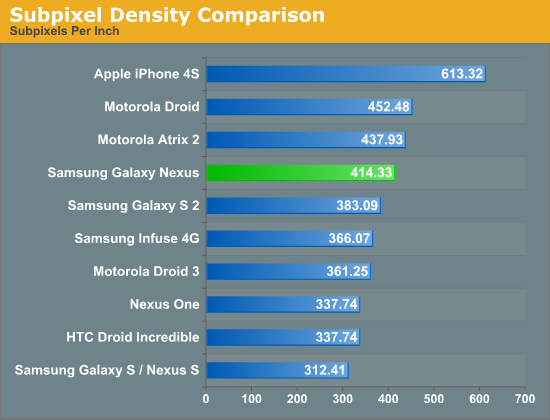Confirmed: Galaxy Nexus Includes PenTile
by Brian Klug & Jason Inofuentes on October 21, 2011 12:58 AM EST- Posted in
- Smartphones
- Samsung
- Ice Cream Sandwich
- Mobile
- AMOLED
- galaxy nexus
Though we've learned a lot about the Galaxy Nexus specifications already, one of the things that has remained a question thus far is whether its 4.65" 720p HD Super AMOLED display uses an RGB subpixel rendering layout or PenTile. We've now confirmed that the Galaxy Nexus display does in fact use RGBG PenTile, like all the Nexus devices to date. This isn't super surprising considering that Samsung has been pretty good about adhering to all the monikers it has gradually been tacking onto AMOLED. There are a number so far - 'super' connotes an optically bonded panel and digitizer stack, 'plus' connotes an RGB stripe, and now 'HD' connotes, well, 720p. HD Super AMOLED lacks Plus, and thus isn't an RGB stripe.
The next question is just what 4.65" HD Super AMOLED will look like, or whether the presence of PenTile will be as noticeable as previous AMOLED phones like the Nexus S / Galaxy S or Nexus One where it was arguably very noticeable. That said, at some subpixel density it should become difficult to impossible to notice PenTile's presence, it's just a matter of exceeding human visual acuity. Having not seen the Galaxy Nexus in person yet and given the absence of good macro shots of the display, we have put together a numerical comparison pitting the Galaxy Nexus panel up against some other common smartphone displays.
First up is a quick plot of the effective pixel density of some popular displays. Stated another way, this is the pixel density based on the manufacturer's stated logical resolution, which is also the resolution of Android's render target for the phone.

Note that this is the traditional means of reporting pixels per inch that we've published before. However, using this metric is just a bit misleading since it doesn't take into account the difference between 2 subpixel-per-pixel RGBG or RBGW PenTile versus the 3 subpixel-per-pixel RGB stripe. To make for an effective comparison, we've put together another plot where we take into account the presence of PenTile and report subpixel density.

Here things still look pretty good for the 4.65" HD Super AMOLED display, putting it just north of SGS2's Super AMOLED Plus display with an RGB stripe. I wager that if you were satisfied with the pixel density of SGS2 that the pixel density Galaxy Nexus actually won't be off-putting despite the presence of PenTile. In addition, hopefully some of the UI design considerations that come along with using PenTile (no vertical 1 pixel thick elements) have been taken into consideration from the outset for Ice Cream Sandwich. For true subjective impressions however, we'll have to wait and see.
Source: Data










152 Comments
View All Comments
Taracta - Friday, October 21, 2011 - link
720 remains 720 it does not decrease in the vertical.Brian Klug - Friday, October 21, 2011 - link
Oh very good point! I made the same mistake that spawned all of this in my attempt to approach the problem from another direction, haha-Brian
schriss - Friday, October 21, 2011 - link
Forgetting the numbers, can you compare opening a complex website on Galaxy S II and Galaxy Nexus? Like, despite all these subpixels talk (sounds like fake HD to me), would a browser still show much more content on Galaxy Nexus than Galaxy S II? I mean resolution is higher, so I assume yes. I have seen few Galaxy Note hands-on videos but don't remember anyone opening a browser and comparing what they see with other phones.What I need from Galaxy Nexus is to display more content in the browser, almost like on a laptop, with no need to zoom in as much as I would have to do on Galaxy S II, my current phone.
JasonInofuentes - Friday, October 21, 2011 - link
I wish I could say it was this simple but the phone's software can manipulate the render to better conform to the screen and that manipulation can be different between two phones.What I can say is that if you could pull up the same browser with the same settings on each phone it should show more of the website on the Nexus than on the S II. Cheers.
schriss - Friday, October 21, 2011 - link
Thanks, that's what I hope for. I will be using the same browser: Firefox Nightly builds. Too bad none of the hands on videos tried to show off the browser and how much of a website fits the screen and how is it readable.I wonder how clear the text is going to be.
JasonInofuentes - Friday, October 21, 2011 - link
And so to fill you all in, all of this started because Brian and I both were independently wrapping our heads around how best to gauge these displays in a data driven way. Obviously it's becoming more complex by the moment. Sigh.WaltFrench - Friday, October 21, 2011 - link
How about we compare the number of sub-pixels per screen? That gets away from so much confusion.If you hold a 4" diagonal device at a distance of 8" from your eyes, each pixel will take up the same visual space (“subtend the same visual angle”) as a 5" diagonal gadget at 10" (if both screens have the same number of pixels). Maybe you want to compare holding both at 9", but that's obviously sub-optimal for both, in terms of blockier pixels or smaller-appearing screen, take your poison. We over-40 types might prefer bigger screens that we could hold farther away for presbyopia, but I actually enjoy my iPhone up real close because I like just a bit of edge from seeing some pixel detail.
It's obvious that the PenTile layout works better for some things than others, but that's also true for the RGB stripe layouts. Our alphabets emphasize long vertical strokes, so vertical detail isn't as important as horizontal in distinguishing, say “darn” from “dam.” Since phones are used both portrait and landscape, you need very fine resolution to make small text legible in either mode.
PenTile isn't as susceptible to H vs V but it is much MORE susceptible to fuzziness (eyestrain & slower reading) when you have common arrangements such as blue text on white screens, or the worst, Red on Blue (since there's the worst likelihood of being able to choose between red and blue when the driver wants to). How often do these cases come up? Well, in photos, it's common to have detail in red and blue, so PenTile is probably fuzziest for photos.
While not particularly worse for B/W text. With optimized drivers that I have yet to see — actually, the opposite is what Android/Sammy seem content with — PenTile could deliver very sharp B/W text.
Finally, a quibble: in dividing the iPhone's pixels per inch by the sub-pixels per inch, I *don't* get the square root of 3, as I think I should. How were the figures derived?
WaltFrench - Friday, October 21, 2011 - link
From DisplayMate.Com:“Most reviews of displays in Smartphones and Tablets are filled with imprecise and incorrect statements and analysis from reviewers that don't understand what the display specs actually mean, don't understand how to objectively evaluate display technology, and haven't performed any lab measurements to verify or quantify their conclusions. If any of this matters to you then read these expert articles...”
This post, and virtually ALL the comments, validate DisplayMate's claims.
ydgmdlu - Friday, October 21, 2011 - link
The Atrix 2, which has a qHD Super AMOLED display, is shown in the first chart to have lower pixel density than the Galaxy Nexus. But in the second chart, it is shown to have greater sub-pixel density than the Galaxy Nexus. This is only possible if the Atrix 2 has an RGB-stripe panel. However, other places have reported that it also uses PenTile. Since Samsung controls Super AMOLED technology, for another vendor's device to boast a superior version of Super AMOLED is unthinkable. The Galaxy Nexus's display is already more advanced that the Galaxy S II's because the sub-pixels are so much smaller. I have to believe that the reason why the Galaxy Nexus has a PenTile display is simply because RGB at 315 ppi is not yet possible for AMOLED.ydgmdlu - Friday, October 21, 2011 - link
Oops, my bad. I confused the Atrix 2 with the Droid RAZR. I stand corrected; the second chart is accurate.